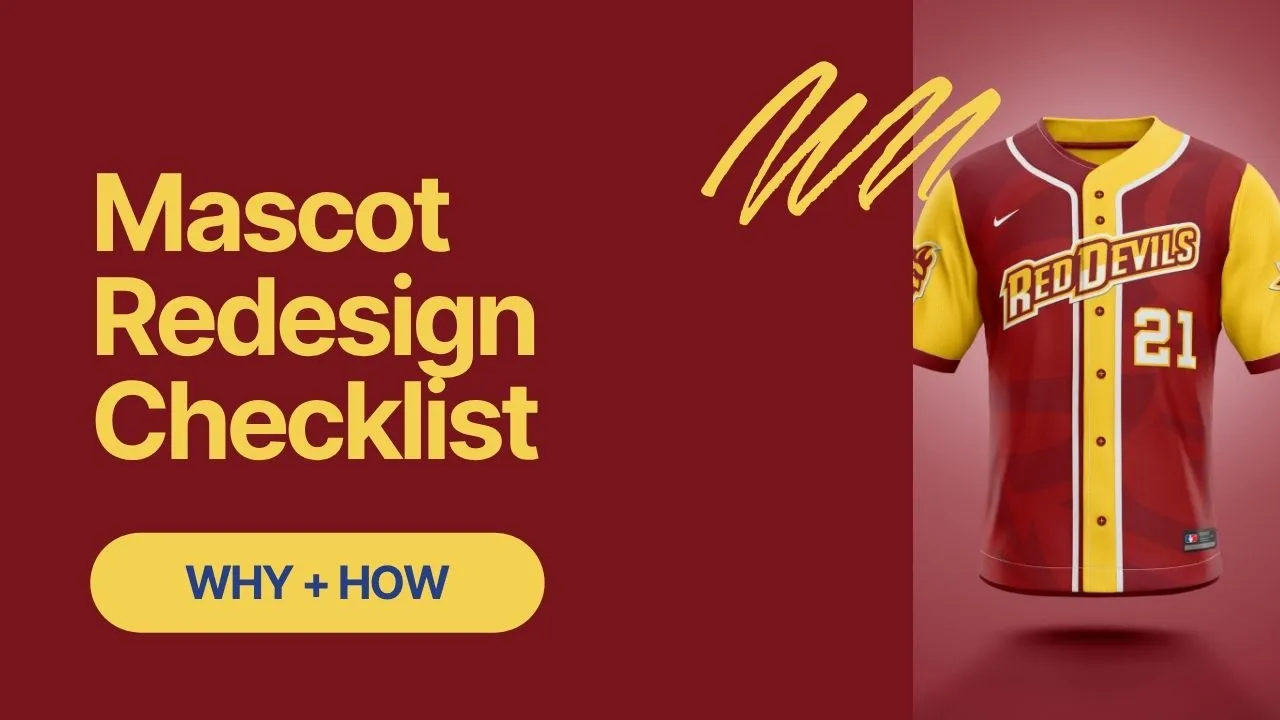School Branding Blog
School Mascot Redesign Checklist: Signs It’s Time + Realistic Timeline

When should a school mascot be redesigned versus lightly refreshed? Below is a practical checklist we use with K‑12 leaders to decide quickly, protect community pride, and avoid rework.
10 Signs It’s Time to Redesign
Not every mascot needs a full overhaul. These signs point to problems that simple tweaks can’t solve—especially when uniforms, signage, and social graphics need to be clear at a glance.
- Files are raster-only (PNG/JPG) and vendors request vector files (EPS/SVG/AI)
- The mascot loses detail at distance on uniforms, fields, or gym walls
- Inconsistent versions across athletics and academics cause confusion
- The mark contains gradients/thin outlines that don’t reproduce
- You can’t get a clean one-color version for vinyl, embroidery, or paint
- The mascot style clashes with updated typographic/brand direction
- There’s no usage guide and booster groups create off‑brand versions
- Legacy clipart or stock mascot was used and resembles other schools
- Community feedback: “busy,” “hard to read,” or “not kid‑friendly”
- Legal/IP ownership is unclear (no license or rights transfer)
What a redesign actually changes
A proper redesign doesn’t just deliver “a nicer picture.” It gives you:
- A primary mascot that reads at distance (field, gym, scoreboard)
- Sport marks and one‑color versions that reproduce cleanly
- Consistent type and color specs so vendors don’t guess
- A simple usage sheet that coaches and boosters can follow
Don’t “Tweak” What Needs Re‑engineering
Minor edits rarely fix systemic problems like distance legibility or inconsistent sub‑marks. A structured redesign creates a primary mascot, sports marks, one‑color versions, and a simple usage guide vendors can follow.
Common “tweaks” that fail: thinner outlines that disappear at distance, adding gradients that won’t embroider, or stretching old art to fit new contexts. If the issue is legibility or consistency, the foundation—not the decoration—needs attention.
6–8 Week Timeline (Typical)
Leaders often ask, “How long will this take, and who needs to be involved?” Here’s a realistic rhythm we use so decisions don’t drag and vendors get exactly what they need.
- Week 1: Discovery (stakeholders, constraints, use cases)
- Week 2–3: Three design directions with in‑context mockups
- Week 4–5: Refinement on chosen direction; one‑color/alt versions
- Week 6: Final prep, guidelines, vendor‑ready files, rights transfer
- Optional Rush: 4–6 weeks for urgent athletic seasons
Who’s involved
- Principal/AD: sets goals, approves direction
- Coaches/Boosters: react to uniforms and game‑day mockups
- Office/Comms: checks readability for website, flyers, email headers
Stakeholder Plan That Avoids Backlash
Most pushback comes from surprises, not from the design itself. Involve a small, representative group and show the mascot in real‑world mockups (jerseys, gym banners, social headers) so people react to context—not guesswork.
- Identify 6–10 voices: athletics, activities, principals, superintendent, boosters
- Share the rationale: distance legibility, reproduction, unity, ownership
- Show in‑context proofs: uniforms, scoreboard, signage, social headers
- Decide governance: who approves new uses and secondary marks
Simple talking points
- “We’re not changing who we are; we’re making sure our mascot works everywhere it needs to.”
- “This file set saves money and time because vendors won’t need redraws.”
- “Students will see the same identity on jerseys, in the gym, and online—more pride, less confusion.”
File & Ownership Checklist
If vendors have these files on day one, orders move fast and quality improves. This set also protects the district’s ownership and avoids redraw fees later.
- Vector: AI/EPS/SVG; Web: PNG/JPG/WebP; Color + one‑color
- Typography + color specs (PMS/CMYK/RGB/HEX)
- Usage guide: do/do‑not, clear‑space, minimum size
- Rights transfer letter and license terms
Where to store
- Create a shared folder named “Mascot Files – Approved” with dated sub‑folders.
- Keep a read‑only “Quick Start.pdf” that explains which files to send to printers.
Frequently asked questions
Will students be upset? Students are usually positive when they see the mascot in context—on hoodies and banners—rather than as a flat file. Involve a small student voice early and show mockups.
Do athletics and academics need different versions? They need the same identity prepared for different uses. Athletics use bolder, simplified marks; academics focus on readability in print and on screen.
What if boosters keep using old art? Provide the new file pack, remove old links, and route orders through a single request form. Most drift is a file access problem.
One‑page plan you can copy
- Pick a small review group (AD, coach, principal, comms, one student).
- Approve goals: legibility, one‑color, vendor readiness, shared type/colors.
- Review three directions in real mockups; choose one; refine.
- Deliver the file pack + Quick Start; update links on website shared drives.
- Announce with pride: “Same spirit, stronger identity.”
What’s Next
Need a professional redesign plan? Our mascot logo design service delivers vendor‑ready files, guidelines, and rollout support. Prefer to scope now? Get a quote.
Further reading
How School Branding Influences Parent Choice
Psychology and decision drivers behind enrollment.
School Branding That Drives Enrollment Growth
Strategic implementation guide for leaders.
School Website Optimization for Enrollment
Turn website traffic into inquiries and tours.
School Logo Design Psychology
Build trust and pride with your visual identity.
Mascot & Logo Design Service
Core service built for pride, clarity, and adoption.
School Branding Strategy Service
Positioning and messaging that convert families.
School Branding Glossary
Clear definitions to align staff and vendors.
Brand Assessment Quiz
Get a personalized report with next-step priorities.
Mascot logo design
Get an enrollment-ready mascot your community loves
Start with our mascot logo design service. We’ll craft a distinctive, on‑brand mascot system and rollout plan tailored for your school.
Start your estimate